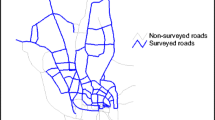Abstract
Recognition has grown among policy-makers that early in the decision-making process, there is a need for an environmental assessment of the effects of the policy, plan, and program (PPP) and their alternatives. Strategic environmental assessment (SEA) is widely recognized as a supporting tool that systematically integrates environmental aspects into strategic decision-making processes, thereby contributing to sustainable development. In this study, SEA was applied for an integrated assessment of environmental, social, and economic impacts of a wide range of scenarios for transport-related air quality policies to help decision-makers in identifying the most sustainable scenario with the purpose of reducing carbon monoxide (CO) concentrations from transport emissions in Hanoi City, Vietnam. In conducting SEA process, the urban air dispersion model MUAIR was used as a quantitative tool in prediction of CO concentrations. To evaluate the predicted impacts of scenarios, the SEA objectives concerning sustainability and the corresponding sustainable indicators were identified. Based on the likely significant predicted impacts on landscape, biodiversity, and health benefits, mitigation measures were proposed. These included planning in infrastructure development and implementation of public education campaign. The results of predicted and evaluated impacts of scenarios as well as proposed mitigation measures were taken into account for supporting sound decision-making that is consistent with the principles of sustainable development. Considering sustainable impacts of the scenarios, the SEA result clearly indicates that a combination of policy for public transport development and policy for installation of oxidation catalytic converter for motorcycles is the most sustainable scenario for reducing CO concentrations from transport emissions.


Similar content being viewed by others
References
Alshuwaikhat, H. M. (2005). Strategic environmental assessment can help solve environmental impact assessment failures in developing countries. Environmental Impact Assessment Review, 25, 307–317.
Arce, R., & Gullon, N. (2000). The application of strategic environmental assessment to sustainability assessment of infrastructure development. Environmental Impact Assessment Review, 20, 393–402.
Brown, A. L., & Therivel, R. (2000). Principles to guide the development of strategic environmental assessment methodology. Impact Assessment and Project Appraisal, 18, 187–208.
Clark, R. (2000). Making EIA count in decision-making. In M. R. Partidário & R. Clark (Eds.), 2000 (pp. 15–27). CRC-Lewis, Boca Raton, FL: Perspectives on Strategic Environmental Assessment.
DOE. (2005). A practical guide to the strategic environmental assessment directive. Practical guidance on applying European Directive 2001/42/EC “on the assessment of the effects of certain plans and programmes on the environment”.
Donnelly, A., Jones, M., O’Mahony, T., & Byrne, G. (2007). Selecting environmental indicator for use in strategic environmental assessment. Environmental Impact Assessment Review, 27, 161–175.
EarthTrends. (2003). Climate and atmosphere—Vietnam. Retrieved September 25, 2010, from World Resources Institute Web site: http://earthtrends.wri.org.
European Commission. (2001). Strategic environmental assessment of transport corridors: Lessons learned comparing the methods of five member states.
European Commission. (2005). The SEA manual. A source book on strategic environmental assessment of transport infrastructure plans and programmes.
European Conference of Ministers of Transport. (2000). Strategic environmental assessment for transport. OECD Publications Service, 2, Andre Pascal, 75775 PARIS CEDEX 16, France.
Fischer, T. B. (1999). Benefits arising from sea application—a comparative review of north west England, Noord-Holland, and Brandenburg-Berlin. Environmental Impact Assessment Review, 19, 143–173.
Goodland, R., & Mercier, J. R. (1999). The evolution of environmental assessment in the world bank: From approval to results. Paper No 67. Environmental Management Series. Washington, DC: World Bank.
Hoang, M. H. (2003). Results of 1994 national GHG inventory in Vietnam and GHG emission projection. Presented at the Workshop of GHG Inventories in Asia Region, November 2003, Phuket, Thailand.
International Energy Agency (IEA). (2005). Carbon dioxide emissions by economic sector. Retrieved September 25, 2010, from International Energy Agency Web site: http://data.iea.org/ieastore.
Noble, B. F. (2002). The Canadian experience with SEA and sustainability. Environmental Impact Assessment Review, 22, 3–16.
Noble, B. F., & Storey, K. (2001). Towards a structured approach to strategic environmental assessment. Journal of Environmental Assessment Policy and Management, 3, 483–508.
Oanh, N. T. K. (2002). Algorithm of simple dispersion model for urban area sources. Bangkok, Thailand: Asian Institute of Technology.
Parkhurst, G., & Richardson, J. (2002). Modal integration of bus and car in UK local transport policy: The case for strategic environmental assessment. Journal of Transport Geography, 10, 195–206.
Partidario, M. R. (1996). Strategic environmental assessment: Key issues emerging from recent practice. Environmental Impact Assessment Review, 16, 31–55.
Partidario, M. R. (2000). Elements of an SEA framework-improving the added-value of SEA. Environmental Impact Assessment Review, 20, 647–663.
Pope, J., Annandale, D., & Morrison-Saunders, A. (2004). Conceptualising sustainability assessment. Environmental Impact Assessment Review, 24, 595–616.
Runhaar, H., & Driessen, P. P. J. (2007). What makes strategic environmental assessment successful environmental assessment? The role of context in the contribution of SEA to decision-making. Impact Assessment and Project Appraisal, 25, 2–14.
Sadler, B. (1998). Report on the international seminar on SEA. DETR: Lincoln. UK.
Sadler, B., & Verheem, R. (1996). Strategic environmental assessment-status, challenges, and future directions. Amsterdam: Ministry of Housing, Spatial Planning and the Environment.
TDSI. (2005). Partnership for sustainable urban transport in Asia—Hanoi City, Vietnam. Final report.
Vietnam Register. (2002). Integrated action plan to reduce vehicle emissions in Vietnam. Regional Workshop: Transport Planning, Demand Management and Air Quality, Manila, Philippines.
Voorhees, S. S., Sakai, R., Araki, S., Sato, H., & Otsu, A. (2001). Cost-benefit analysis methods for assessing air pollution control programs in urban environments-a review. Environmental Health and Preventive Medicine, 6, 63–73.
Wood, C. (1995). Environmental impact assessment: A comparative review. Longman: Harlow.
Acknowledgments
We would like to thank Dr. Nguyen Thi Kim Oanh from Environmental Engineering and Management, Asian Institute of Technology, Thailand for providing us the urban air dispersion model MUAIR used in this study.
Author information
Authors and Affiliations
Corresponding author
Additional information
Readers should send their comments on this paper to BhaskarNath@aol.com within 3 months of publication of this issue.
Rights and permissions
About this article
Cite this article
Nguyen, D.L., Coowanitwong, N. Strategic environmental assessment application for sustainable transport-related air quality policies: a case study in Hanoi City, Vietnam. Environ Dev Sustain 13, 565–585 (2011). https://doi.org/10.1007/s10668-010-9277-1
Received:
Accepted:
Published:
Issue Date:
DOI: https://doi.org/10.1007/s10668-010-9277-1




